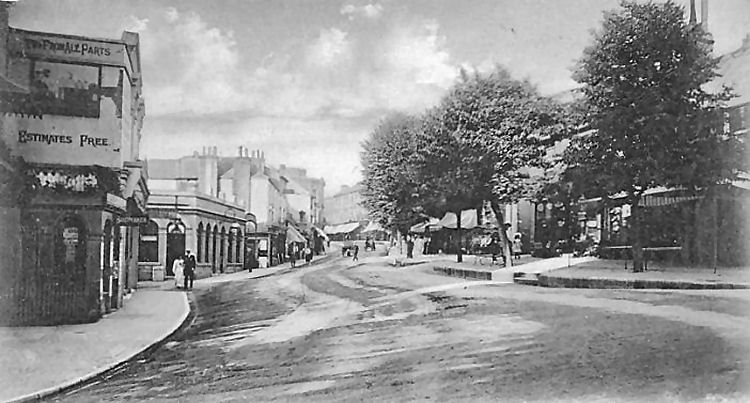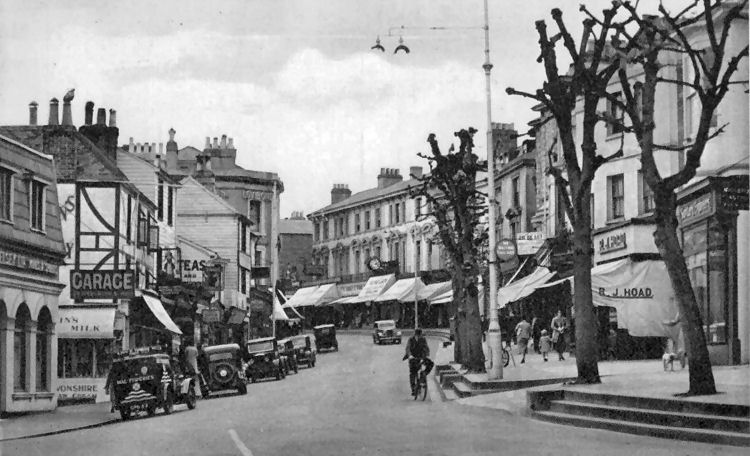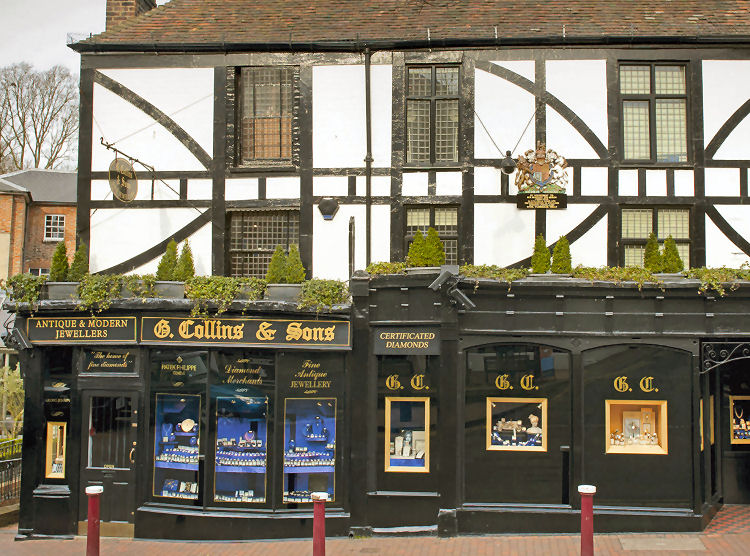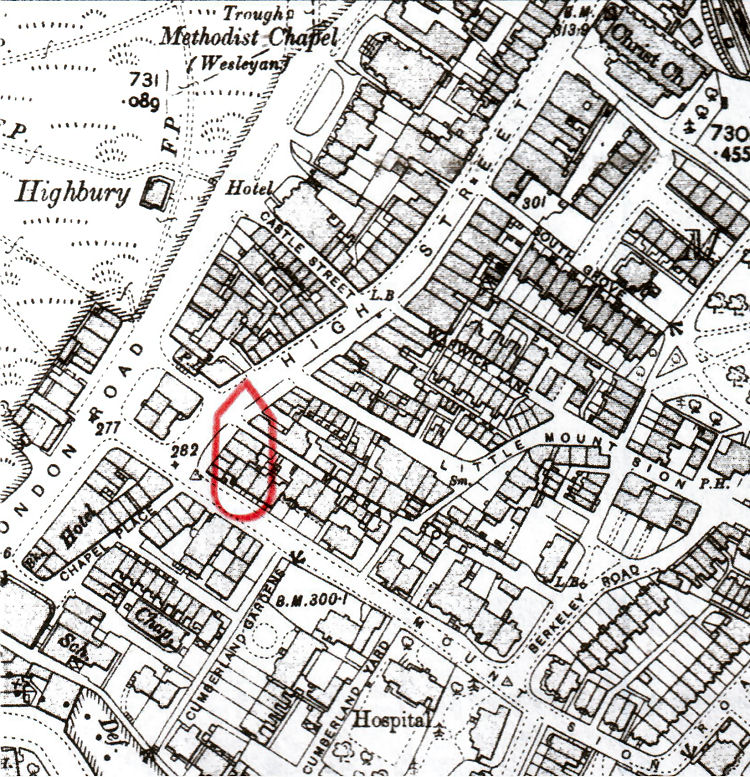|
Written By: Edward James Gilbert-Thunder Bay, Ontario, Canada. 18 November, 2017.
THE NEWCASTLE TAVERN
The Newcastle Tavern was referred to variously as a tavern and as a
beerhouse and was located at 76 High Street, Tunbridge Wells on the west
side of the High Street at the south end just north of the junction of
the High Street with Mount Sion Road.
The earliest reference found for this tavern was William Moon in 1874,
listed as a beer retailer. (Now predated to William Barden in 1871.
Frederick Barden was born in Tonbridge in 1841 (baptised on 24 January)
and his parents were William Barden and Sarah (nee Rabbet), who were
both born in Hadlow. Frederick married Emma Maynard in 1868 and they had
a daughter who was 4 months old at the time of the 1871 census.) By the time of the 1881 census the
establishment was taken over by Philip Butler. Philip had been born 1842
at Ticehurst, Sussex one of five children born to Henry Butler
(1789-1874) and Judith (Judy) Walker Chantler Butler (1801-1875).
Henry’s wife Judith had been previously married and had several children
with the surname of Chantler. The 1851 census, taken at
Ticehurst gave Henry Butler as an agricultural labourer. With him was
his wife Judy; three Chandler children and four Butler children,
including Philip who was attending school. The 1861 census, taken at
High Street, Ticehurst gave Henry Butler as an agricultural labourer.
With him was his wife Judith; their son Philip, an agricultural
labourer, and one granddaughter. No 1871 census for the family was
located.
The 1881 census, taken at 76 High Street gave Philip Butler as a
beerhouse keeper. With him were five boarders. Next door at No. 74 was
at that time George Donevan, a 29 year old cabinet maker with his
family. At No. 78 in 1881 was Edward Kingswood, a 35 year old boot maker
and his family.
Philip soon after the 1881 census vacated the Newcastle Tavern and
Thomas Field took over, who was there up to June 1882 when the licensee
became James Coomber. James remained there for a few years. The next
person to run the business was Henry Rogers who remained there until
September 1889. He was followed by Frederick who was there from 1889 to
1891. Who ran the business after 1891 up to 1908/1909 was not
established.
The Civic Society book by Chris Jones entitled ‘Tunbridge Wells in 1909’
refers to the Women’s Temperance Movement in the town in the early
1900’s and that the 1904 Act had sought to reduce the number of licensed
premises in the town. The Act introduced compensation for premises that
were closed by the Act. Among the establishments closed was the
"Newcastle Tavern" who’s license was refused and “which everyone knew was
suffering such poor trade that it could not pay its rates. How
convenient that Kelseys should receive £250 compensation to close
it”.
In 1908/1908 Clifford Walter Revell moved into 76 High Street and from
this location operated his photographic dealers business until he died
there in 1956.
Since 1956 No. 76 High Street has been the premises of several
businesses. Among them is perhaps the longest tenant, namely G. Collins
& Sons who have operated their jewellers business at that location since
1986 and are still in operation there today (November 2017).
CLIFFORD WALTER REVELL-THE PHOTOGRAPHIC DEALER.
Clifford Walter Revell (1880-1956) was born in Great Clacton, Essex, one
of several children born to Robert Smith Revell, a grocer and draper
born in Suffolk in 1849, and Fanny S. Revell, born 1847 in Great
Clacton. Clifford’s mother Fanny passed away in 1882 and his father then
married Alice Simpson with whom he had no children.
Clifford was living with his parents and siblings on Brook Street in
Great Clacton at the time of the 1881 and 1891 census, and was attending
school.
At the time of the 1901 census Clifford was living as a boarder on
Brampton Road in London where he was working with 18 others as a
draper’s assistant.
By the time of the 1911 census, Clifford was living in Tunbridge Wells
at his photographic dealers shop at 76 High Street, which building had
been the premises of the "Newcastle Tavern" Beerhouse from 1874 until the
women’s temperance movement forced a cancellation of its license in
1909 and Clifford took over the premises for his shop.
In the 2nd quarter of 1914 Clifford married Edith Rosewarne Wren. Edith had
been born 1885 in Finchley, Barnet, Middlesex, one of two known children
born to Edward Stephen Wren, a ladies costume manufacturer and retailer,
born 1849 in Westminster, London, and Catherine Husking Wren, born 1849
in Cornwall. Edith was living with her parents and siblings in Finchley
in 1891 but by 1901 was living with them in Islington, London where her
father was running a ladies outfitters shop. At the time of the 1911
census Edith was living in Tunbridge Wells where she met and fell in
love with Clifford, and was working at that time as a draper’s clerk in
a large drapers business at 15-21 High Street, a business managed
by Henry John Blow, a 55 year old gentleman born in Marylebone, London.
In total the business employed 10 drapers assistants, 2 dressmakers and
one drapers clerk.
The Royal Navy Registers of seamen’s services during WW 1 record that
from 1917 to 1918 Clifford served with the Royal Navy Air Service (RNAS).
During the war his wife ran the photographic dealers business and when
the war ended Clifford returned to Tunbridge Wells to take over its
operation. His wife for many years assisted her husband in the business.
Clifford was referred to both as a photographic material dealer and a
photographer but no examples have been found to date of any photographs
bearing his name. However, it was quite common for photographic dealers
to take portrait photos (CDV’s) in their shop. Clifford sold all types
of camera equipment, photographic chemical/paper/plates and film etc.
and did such a good business that he was still there when he died in the
shop in 1956.
Clifford and his wife had just one child, namely the well-known
economist, of international reputation, John Robert Stephen Revell
(1920-2004) who had been born in Tunbridge Wells and was educated at
Skinner’s School on St John’s Road, Tunbridge Wells. He later went on to
obtain a degree at the London School of Economics. He held many
important positions over his career and was the author of some 30 books
and over 75 articles. He married Pat Hyatt in 1946 and with her had one
son and two daughters. He died in Cambridge 4th November, 2004.
THE REVELL FAMILY –THE EARLY YEARS.
Clifford was born 30th August, 1880 at Great Clacton, Essex, the son of
Robert Smith Revell (1849-1933) and Fanny S. Revell, nee Parker
(1847-1882). Robert and Fanny’s marriage was registered in the 4th qtr
of 1869 at Tendring, Essex. Clifford was baptised 1880 at St John the
Baptist Church in Clacton on Sea.
Robert Smith Revell was born 1849 at Woodbridge, Suffolk and his wife
Fanny was born 1847 at Great Clacton, Essex, the daughter of Sophia
Parker who was born 1816 in Martlesham, Suffolk. Sophia was a widow by
the time the 1881 census was taken.
Clifford Walter Revell was one of eight known children born to Robert
Smith Revell and his first wife Fanny.
The 1881 census, taken at Brook Street in Great Clacton, Essex gave
Robert Smith Revell as a draper employing two men. With him was his wife
Fanny and six of their children born at Great Clacton between 1871 and
1880, of which Clifford was the youngest and appears to have been the
last child born to the couple. Also there were two shopmen and Sophia
Parker, the widowed mother of Fanny S. Revell, nee Parker. Fanny’s death
was registered in the 3rd quarter of 1882 at Tendring, Essex, having died at
Great Clacton.
The 1891 census, taken at Brook Street, Great Clacton, Essex gave Robert
Smith Revell as a grocer. With him was his second wife Alice Simpson
Revell who was born 1857 at Holland, Essex.
The marriage between Alice Simpson Revell, nee Lucas, and Robert Smith
Revell was registered at Kensington, London in the 1st qtr of 1884.
Based on the 1891 census Robert and Alice had three children between
1885 and 1890. Since Alice was just age 33 in 1890 it is likely that the
couple had more children after the birth of Stanley Revell in 1890.
Sometime after the 1891 census Clifford left the family home and began
his working career. He was found in the 1901 census living as a boarder
at 112 Brompton Road, Westminster, London, where he and 17 other
boarders were working as drapers assistants and drapers clerks. The
person in charge of this place of residence/work was Thomas Wheatley who
lived there with his family. Thomas was listed in the census record as
the caretaker of the premises.
In 1908 Clifford moved to Tunbridge Wells and opened a photographic
dealers business at 76 High Street.
CLIFFORD WALTER REVELL IN TUNBRIDGE WELLS.
Clifford was working as a draper’s assistant in Westminster, London at
the time of the 1901 census. He had taken up this line of work since his
father Robert Smith Revell was, at the time of the 1881 census on Brook
Street in Great Clacton, both a grocer and draper employing two shopmen.
At the time of the 1891 census Clifford was still in school, but his
sister Fanny, age 16, was working for her father as a drapers assistant.
Although in the 1891 census Robert Smith Revell was only listed as a
grocer it is most likely that he was both a grocer and draper. His son
Ernest William Revell in 1891 was working for his father as a grocers
assistant.
The 1911 census, taken at 76 High Street gave Clifford as a single
gentleman with the occupation of photographic dealer on own account at
home. Clifford lived above the ship in what was described as premises of
6 rooms.
In the second quarter of 1914 Clifford married Edith Rosewarne Wren
in Tunbridge Wells. Which church they were married at was not
established but most likely was Christ Church on the High Street.
Edith Rosewarne Wren was born in the 3rd quarter of 1885 in Finchley,
Barnet, Middlesex. Although her middle name appears in most records,
including her probate record as Rosewarne, she was baptised as
“Rosewarn” October 4,1885 at Holy Trinity, Finchley, Barnet, Middlesex. Edith was one of two known children born to Edward
Stephen Wren and Catherine Hosking Wren. At the time of her baptism her
father was recorded as a “manufacturer”.
The 1891 census, taken at Ivy Cottage in Finchley gave Edward Stephen
Wren, born 1849 at St James London as a “dress costume manufacturer”.
With him was his wife Catherine, born 1849 Cornwall, and their two
children Harold, age 8, and Edith, age 5. Also there was a cousin Edward T.
Ayor, a dress costume manufacturer.
The 1901 census, taken at 169 Stroud Green Road in Islington, London
gave Edward Stephen Wren as a ladies outfitter. With him was his wife
Catherine; their two children Harold, a commercial clerk, and Edith of
no occupation. Also there was Edwards cousin Edward T. Ayor, a ladies
costumer.
Sometime after 1901 and before 1911 Edith moved to Tunbridge Wells. She
was found in the 1911 census at 15-21 High Street in the employ of
Henry John Blow, age 55, a “manager counting house draper”. Edith was
working there as a clerk in the drapers business. With her was 10
assistant drapers and two dressmakers. The census recorded that the
premises were of 14 rooms.
No. 15-21 High Street were located at the northern end of the High
Street south of the High Street Bridge. This business was obviously a large one. At the time of
the 1881 census No. 15-21 High Street was four separate shops with No.
15 being the silk mercers shop of Walter Ellis; No. 17 a pharmaceutical
and chemists shop of Robert Bennett; No. 19 the jewellers shop of George Farrer and No. 21-23 the drapers and milliners shop of Thomas H. Jones
who had working for him 8 drapers and dressmakers and one domestic
servant.
Clifford Walter Revell and his wife Edith had just one child namely John
Robert Stephen Revell (1920-2004) who was born in Tunbridge Wells in the
2nd qtr of 1920.
Clifford served during WW 1 with the Royal Navy Air Service (RNAS) from
1917 to 1918. While he was away his wife Edith ran the business at 76
High Street. Clifford’s war service records can be found online and
record that he had been born 30 August,1880 at Clacton On Sea and that
he first served 17th May,1917 (service # 229335) with his next of kin
given as his wife Edith Rosewarne Revell. The Royal Navy Register
expanded on the above by recording that the first vessel Clifford served
on was the PRESIDENT II. His last date of service was 31st March,1918 on
the H.M.S. DAEDALUS. The military records gave his occupation as
“photographer”.
After Clifford’s war service ended her returned to Tunbridge Wells and
took over the running of the business at 76 High Street from his wife.
The National Archives have in their collection the business ledger of
his business covering the period of 1935-1956 and record him as a
“photographer”. No listings of any “photographer” was found was found at
76 High Street in the directories of 1903,1913 and 1918 but Clifford is
listed there as a photographic material dealer in 1913 and 1918 and also
in directories with the same occupation from 1914 to 1938. It is known
from probate records that Clifford was still at 76 High Street at the
time of his death in 1956.
Probate records for Clifford Walter Revell gave him of 76 High Street,
Tunbridge Wells and that he died February 6,1956. The executor of his
£527 estate was his son John Robert Stephen Revell, a journalist.
No burial or cremation record for Clifford was found at the Tunbridge
Wells Borough Cemetery/Crematorium.
The probate record for Clifford’s widow, Edith Rosewarne Revell gave her
of 4 Windsor Road in Cambridge and that she died 14th September,1963. The
executor of her £561 estate was her son John Robert Stephen Revell,
a university research economist. Her son John had been a resident of
Cambridge for many years and it is known that from 1957 to 1963 that
that he was an officer in the Department of Applied Economics at
Cambridge University and it is highly likely that his mother lived with
him and his wife and children at his home in Cambridge. She most likely
left Tunbridge Wells shortly after the death of her husband to live with
her son.
JOHN ROBERT STEPHEN REVELL (1920-2004).
John had been born in Tunbridge Wells. His birth was registered in
Tunbridge Wells in the 2nd quarter of 1920. His date of birth was given as
15th April,1920 and was the only child born to Clifford Walter Revell and
Edith Roswarne Revell, nee Wren.
On the internet one can find a number of websites providing information
about John, who is described as a gentleman with a long and illustrious
career as an economist with an international reputation.
He began is education in Tunbridge Wells, having attended Skinner’s
School on St John’s Road. To date no photograph of John has been located
by the researcher.
John later went on to obtain his bachelor’s degree from the London
School of Economics (LSE). Before going to the LSE in 1947 he spent 10
years in the Civil Service and Army and during that time he became an
Associate in the Institute of linguists (French and Spanish). He
graduated from the LSE in 1950, following which he worked as a research
economist for a commercial organization.
He served as an Officer in the Department of Applied Economics at
Cambridge University 1957-1963; Senor Research Officer 1963-1968;
Director of Studied in Economics, Selwyn College, Cambridge 1960-1965;
Director of Studies in Economics, Fitzwilliam College, Cambridge
1964-1967; Fellow 1965-1968; Tutor in Economics 1965-1967; Senior Tutor
in Economics 1967-1968; Professor of Economics, University College of
North Wales, Bangor 1969-1983. He married Pat Hyatt in 1946 and with her
had one son and two daughters. John died in Cambridge 4th November,2004.
John, most often referred to as “Jack” acquired an international
reputation for his emphasis on the importance of understanding how
financial institutions and markets work in practice in order to help
improve both policy formulation and economic theory development. His
work began in earnest in 1957 at Cambridge University. During the period
of 1969 until his retirement in 1983 John never stopped writing, and
authored some 30 books and over 75 articles on his field of expertise.
On the last decade of his life he wrote on savings banks and cooperative
models of banking and became something of a modern-day guru.
Further details about his life and career can be found from his obituary
by Ted Gardener of 2004 on the website
www.independent.co.uk
under the
heading of “Professor Jack Revell”.
|




